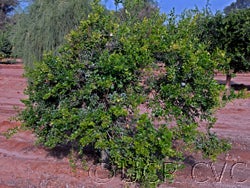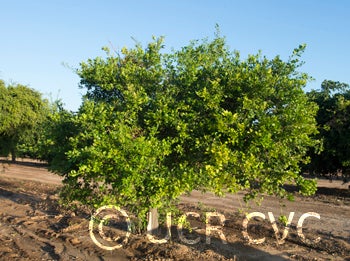Australian round lime
CRC 3668
PI 539739
Source
Received as budwood from Dr. Joe Furr, USDCS, Indio, CA, 1968.
Parentage/origins
Parents unknown.
Rootstocks of accession
Schaub rough lemon.
Season of ripeness at Riverside
July to October
Season of flowering at Riverside
February
Notes and observations
Seeds collected at Imbril, Queensland, by W.V. Mungomery, Dept. of Primary Ind., Maryborough, Sent to J. Furr in 1965. "Rough lime"
Description from The Citrus Industry Vol. 1 (1967)
"Leading terminal twigs straight, very angular, with internodes 1-1.5 cm long, with single slender acute thorns 5-10 mm long; lateral twigs short, slightly angled, with internodes 5-10 mm long, and spines 2-6 mm long; leaves entire, glabrous, or sparingly ciliate on the margin near the base; leaves articulated with the petioles; larger leaves on leading twigs 3-4 X 2-3 cm, obovate to obcordate (sometimes lozenge-shaped on less vigorous leading twigs); leaves of lateral twigs diamond-shaped, 2-3 X 1.2-1.8 cm; veins visible on both surfaces, but more conspicuous below, 12-15 pair arising at an angle of 25°-30° with the midrib and frequently branching, with veinlets arising at a very acute angle and running parallel to the veins; leaves rounded, emarginate or bluntly pointed at tip, cuneate at the base; petioles articulated with the leaf blades, finely pubescent and flattened an the upper side, 2-3 mm long; flowers arising singly in the axils of the leaves, small, 10-15 mm diam., 4- or 5-merous, with 16-20 stamens with free filaments; fruit globose or subglobose, 2.5-3.5 or 5 cm diam., with 6 segments (Schaler's green to grass green; Ridgway, 1912, pl. 6); pulp-vesicles proper (exclusive of stalk) 6-10 X 2.5-3.5 mm, lightly coherent in mature fruits, very pale greenish (water-green, Ridgway, pl. 41) near the peel but much brighter green (light grass-green to grass-green, Ridgway, pl. 3) in the center, irregularly slender-pyramidal or fusiform, more or less angular from pressure, tapering gradually into long, more or less contorted blunt tips, 1-1.5 mm wide, containing numerous large droplets of strong-flavored oil, stalks often very short, sometimes 2-3 mm long, texture of pulp-vesicles firm enough to cut into slices with a sharp knife (much firmer than in any species of Citrus); seeds flattened, containing a single embryo; no clearly defined chalazal cap in spite of the acid nature of the pulp (in Citrus the species with acid pulp have strongly colored chalazal caps).
This species, called "Dooja" by the aborigines and round lime or native orange by the Australians, is native to northeastern Australia. It is readily distinguished from all the other species of Microcitrus (and from Eremocitrus as well) by its globose or slightly pear-shaped, rough-skinned fruits, 2.5 to 5 cm in diameter (about the size of a large walnut), and by its short-stalked pulp-vesicles that taper gradually into blunt tips often more or less deformed and twisted by mutual pressure
The early descriptions of this species and of M. australasica are so meager as to leave doubt concerning which species was being discussed. Fortunately the original descriptions of Citrus australis, published by Planchon in a rare work (Hortus donatensis, 1854-58, p. 18), was based on a specimen in the herbarium of the Muséum d'Histoire Naturelle at Paris, collected by Leichhardt in the vicinity of Moreton Bay in southeastern Queensland. A study of this type specimen makes clear the proper application of the name M. australis.
Penzig (1887, pp. 210-17, pl. 21, figs. 8-13) described in detail the anatomy of this species. He found that the pulp-vesicles were similar to those of the commonly cultivated citrus fruits except that they contain, along their central axis, large masses of yellowish oil. These pulp-vesicles are very different in shape from those of the finger-lime, M. australasica, or those of the other species of Microcitrus.
The Australian round lime, or Dooja, grows to be a tree 30 to 60 feet high and is the largest of any of the native citrus fruit trees. The fruit is said to be used for preserves in Queensland. This species, which has been introduced into the United States, grows well in California, where it is now fruiting. It is exceeded in vigor, however, by the Sydney hybrid, the result of a natural cross of this species with the finger-lime, Microcitrus australasica."
Availability
Not commercially available in California.
USDA Germplasm Resources Information Network page for Microcitrus australis (CRC 3668)



